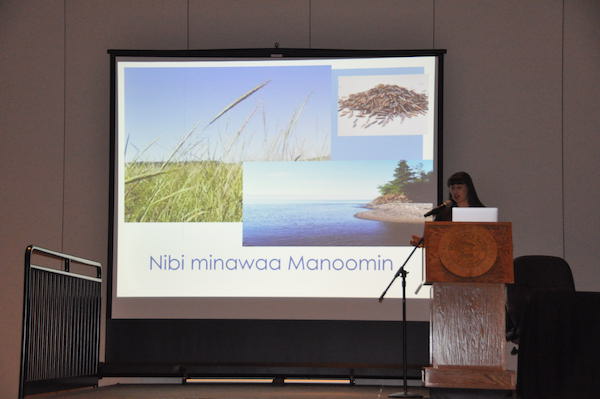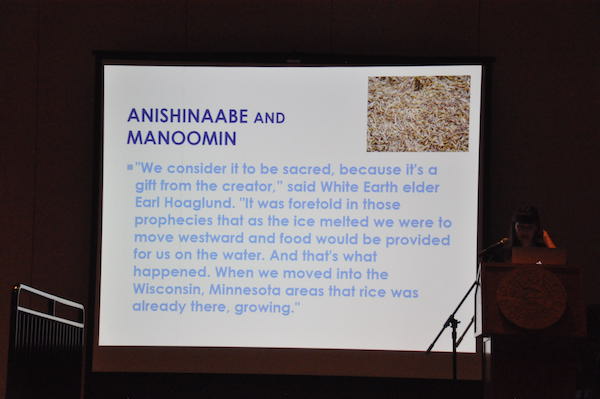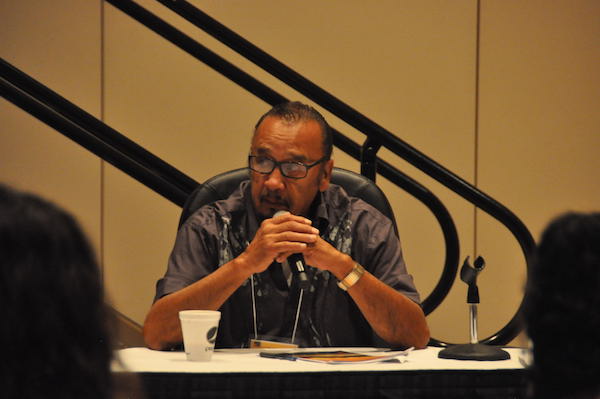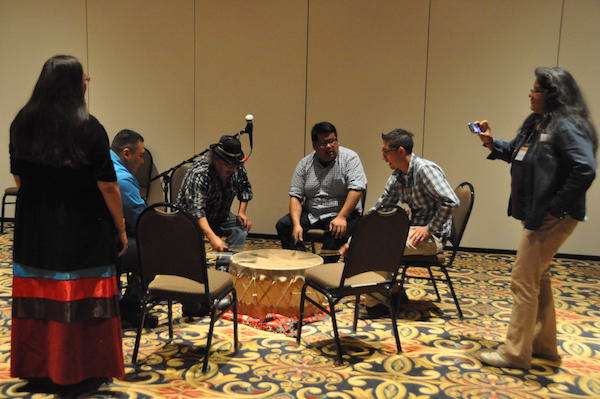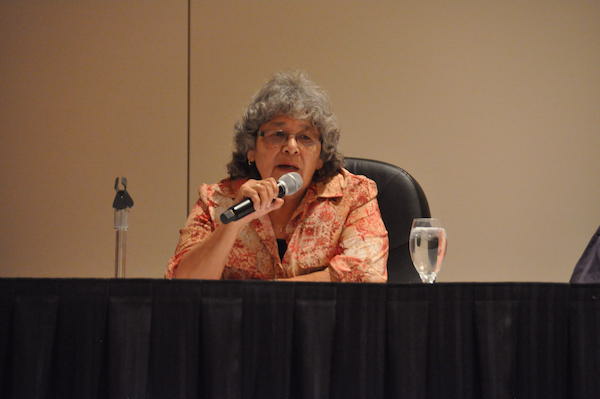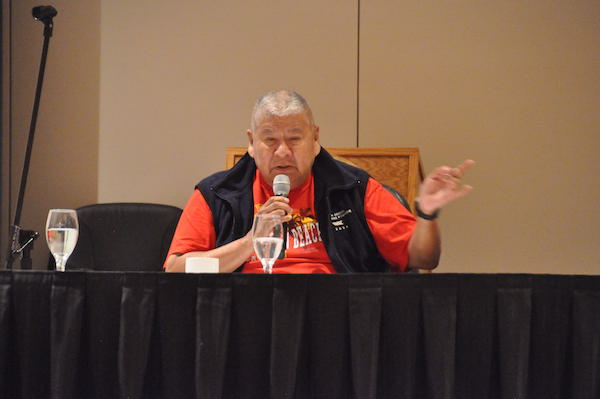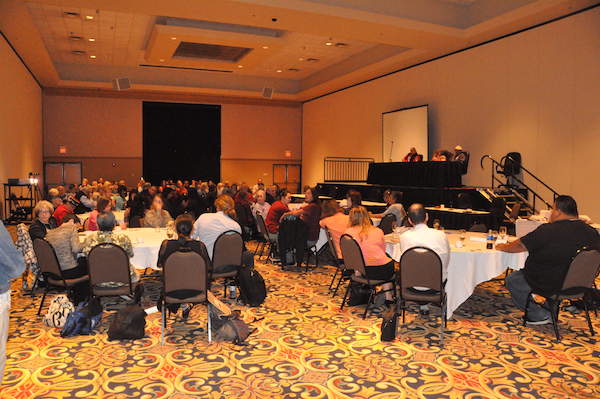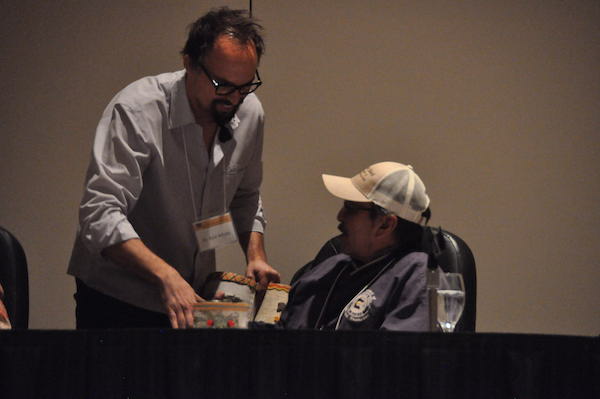
By Brett Larson, September 30, 2015
Over 100 tribal members, educators and scientists gathered at Grand Casino Mille Lacs Sept. 28 and 29 for the Nibi Miinawaa Manoomin (Water and Wild Rice) symposium. The event was sponsored by the Mille Lacs Band and the University of Minnesota.
The theme of the symposium was “Oshki-mikanensan Ji-wiidanokiindiyang Weweni Niigaan Akeyan” or “New Pathways for a Shared Future.”
The focus was “To build lasting relationships in the work of protecting nibi and manoomin for future generations.”
The symposium began with an invocation from Byron Ninham, a drum song by Timber Trails, and a water ceremony by Dorene Day of the Bois Forte Band.
Jill Doerfler of the American Indian Studies program at the University of Minnesota Duluth set the stage by describing how the symposium began and the themes of previous meetings.
Secretary-Treasurer Carolyn Beaulieu gave a welcoming address, telling the story of the Anishinaabe who migrated to the land “where food grows on water.” She stressed the importance of protecting manoomin by working together and valuing both scientific and cultural perspectives.
Carolyn’s welcome was followed by addresses from University of Minnesota officials: Dr. Katrice Albert, Vice President of the Office for Equity and Diversity; Dr. Allen Levine, Vice Provost for Faculty and Academic Affairs; and Dr. Brian Buhr, Interim Dean of the College of Food and Nutritional Sciences.
U of M President Eric Kaler spoke to attendees through a video. Kaler not only expressed support for the symposium but also emphasized the importance of tribal advisory committees at all campuses of the U of M.
After the welcoming addresses, a panel of four rice experts spoke. Mille Lacs Band Wildlife Biologist Kelly Applegate talked about the Band’s efforts with water quality, restoration and wildlife habitat. Lisa David of the Great Lakes Indian Fish and Wildlife Commission spoke about carp and beaver control, genetic engineering, seeding, and unusual weather events resulting from climate change.
Dale Greene of the 1855 Treaty Authority talked about the Treaty Authority as a cooperative effort of the Mississippi, Pillager, White Oak, East Lake and Sandy Lake Anishinaabe communities. He spoke about the historical, legal and cultural issues that influence the management and protection of manoomin. He said the devaluation of Anishinaabe cultural knowledge and practices led to the destabilization and dysfunction of families and communities.
Roger LaBine of the Lac Vieux Desert Band of Lake Superior Ojibwe addressed water pollution and dams that have affected his band’s rice beds, and he outlined the band’s successful restoration efforts.
The symposium continued Monday afternoon with several presentations:
— Protecting Wild Rice from Excess Sulfate by Katrina Kessler of the Minnesota Pollution Control Agency
— The University’s Research History involving Wild Rice by Dr. Alex Kahler
— Taro: A Sacred Food by Jerry Konanui — Native Hawaiian Mahi-ai
Tuesday’s agenda included an opening invocation by Band member Amik and an honor song by Timber Trails, followed by a traditional knowledge panel featuring Mille Lacs Band members Brenda Moose, Henry Sam and Joe Nayquonabe.
Joe shared stories of ricing as a young man near Brainerd, when it was not just a cultural tradition or food source, but also a way to earn money. He called rice “a sacred food,” along with deer and fish, and talked about the need to protect the rice and the water.
Brenda talked about ricing at Rice Lake Wildlife Refuge in District II, and about the history of the East Lake community. To white people, she said, “rice is just a commodity that you see in restaurants, but to us it’s part of who we are as Anishinaabe people. … It’s part of our legends. … When we lose our resources that make us who we are, we become less Anishinaabe. Our language, our foods, our ceremonies, that’s who we are.” Brenda also warned against pollution and pipelines, saying the rice has become smaller, less abundant and less flavorful since she was young.
Henry Sam said he learned about ricing from his parents and grandparents, and he stressed the need to pass that cultural knowledge on to the next generations and to protect the resources.
Larry ‘Amik’ Smallwood, who served as master of ceremonies, also shared stories of ricing during the morning session. Before the session began, he told the guests about the history of the Mille Lacs Band and the casinos, attributing the Band’s success to its adherence to traditions.
“It’s through our prayers and our tobacco and our Big Drums that we’re able to have this building we’re sitting in,” Amik said. “We used to be made fun of back in the ‘70s and ‘60s and ‘50s. They said we were backwards because we spoke our language, and we were poor.”
He talked about Art Gahbow, who was one of the most respected Indian leaders in the country, and about the leadership of Doug Sam and the late Dave Matrious and Albert Churchill, who helped bring the casinos to Mille Lacs and Hinckley while preserving the culture and language.
“Our prayers and our traditional tribal leaders made it possible,” he said. “We’re not laughed at anymore. We still speak our language, and we have our young ones doing our invocations now.”
The morning session ended with a presentation by Dr. Kyle Whyte of Michigan State University on “Respect, Reciprocity and Reconciliation in Cooperative Partnerships.”
The afternoon included working group breakouts and a presentation on building respectful collaborations.
The event closed with a water ceremony led by Dorene Day and a round dance with Timber Trails.
